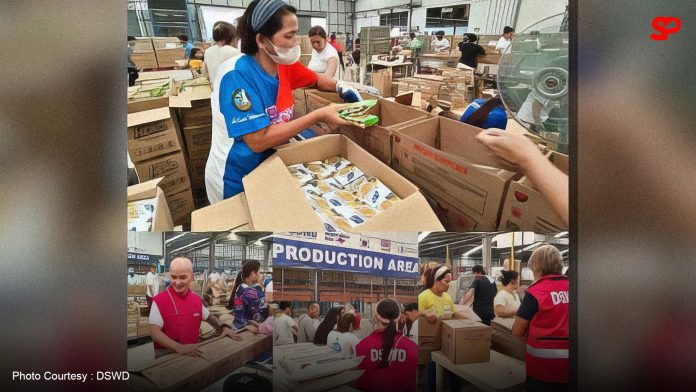MANILA – More than 8 million boxes of family food packs (FFPs) were distributed by the Department of Social Welfare and Development (DSWD) to 6,864,735 families who were affected by the series of disasters across the country in 2024, an official reported on Wednesday.
DSWD Assistant Secretary for Disaster Response Management Group (DRMG) Irene Dumlao said these food packs were part of the 10 million boxes of FFPs produced in record time by the National Resource Operations Center (NROC) in Pasay City and the Visayas Disaster Response Center (VDRC) in Mandaue City, Cebu province.
“While we can relatively attribute this huge number to the severity of tropical cyclones and other calamities, we also see this as a result of our enhanced disaster response operations and stronger collaboration with partner-agencies that enabled us to reach more affected-families,” Dumlao said.
From January to early October 2024, the DSWD focused on humanitarian efforts for families affected by Typhoons Aghon and Butchoy, Severe Tropical Storms Carina and Enteng, Typhoons Ferdie and Gener, Tropical Storm Helen and Tropical Depression Julian, as well as major fires, earthquakes, and volcanic incidents.
“The successive storms that started with Kristine, followed by Leon, Marce, Nika, Ofel and Pepito, and the recent eruption of Kanlaon, increased the number of affected families who were aided by the DSWD,” Dumlao said.
The DRMG official reported that 524,334 families were also provided with the agency’s Cash-for-Work (CFW), Food for Work (FFW), and Emergency Cash Transfer (ECT) programs.
The ECT recipients were given outright cash aid to help them purchase their priority needs and rebuild their lives and livelihoods.
The CFW and FFW beneficiaries were given cash or food after participating in community work and training activities.
1,000 storage facilities
In line with initiatives to fast-track aid delivery in disaster-stricken areas, Dumlao said the DSWD now has close to 1,000 storage facilities nationwide, which include warehouses, hubs, spokes, and last mile facilities.
“The strategic expansion of our warehousing capacity falls under the Buong Bansa Handa (BBH) Project, which establishes two parallel supply chain mechanisms to ensure comprehensive coverage and timely assistance to affected families in all disaster-affected areas,” she said.
The first mechanism features a national and local government-driven supply chain that seeks to increase the production capacities and processes of the NROC and VDRC, and the warehouse and storage facilities across the 16 Field Offices.
For the second mechanism, the department forged partnerships with established large and small groceries, supermarkets, manufacturers, and distributors to leverage on their technical expertise and resources to create a private sector-driven supply chain.
Mobile Command Centers
The year 2024 also showcased the agency’s decisive efforts to disaster-proof its digital monitoring system and communication lines for disaster response and emergency operations through the launch of the Disaster Response Command Center (DRCC), and the Mobile Command Center (MCC).
“These were the projects that were closely spearheaded and supervised not just by our Secretary Rex Gatchalian. These were also shepherded through President Ferdinand R. Marcos Jr.’s vision of a technology-driven disaster management system,” Dumlao said.
In January 2024, the newly-renovated DRCC was unveiled, which coincided with the annual celebration of the DSWD’s founding anniversary.
The DRCC utilizes advanced information and communication equipment/assets to ensure the seamless collaboration between the DSWD’s Central Office, Field Offices (FOs), member-agencies of the National Disaster Risk Reduction and Management Council (NDRRMC), and local government units (LGUs).
The DRCC was soon reinforced by the MCC and provided linkage from the disaster-stricken areas to the Regional Operations Center (ROC), Disaster Response Command Center (DRCC), or the Regional Disaster Risk Reduction Management Council (RDRRMC).
Each MCC is equipped with state-of-the-art satellite internet, gadgets, and generators that have been highly utilized not just as a stable source of power supply and internet connection for disaster responders, but also to disaster-affected communities.
Ready-to-eat food
The DSWD also launched its ready-to-eat food (RTEF) in 2024, the first ever of its kind in the country, particularly intended to supplement free food provision to disaster-hit families.
The RTEF was introduced as the new addition to the agency’s relief items, which will be distributed to affected families within 24 to 48 hours after the onset of a disaster.
The DSWD will start prepositioning RTEF in seaports by 2025 to facilitate the seamless food provision for stranded passengers in times of disasters, including other strategically identified storage facilities nationwide.
Climate change mitigation
From July 2023 to May 2024, El Niño conditions were observed in the tropical Pacific Ocean and its effects were felt in the Philippines resulting in agricultural damages and water shortages reported in various Regions.
In response, the DSWD recalibrated its Risk Resiliency Program (RRP) and launched Project Local Adaptation to Water Access (LAWA) and Breaking Insufficiency through Nutritious Harvest for the Impoverished (BINHI).
“The twin project was particularly designed to mitigate the impact of food insecurity and water scarcity caused by the El Niño while preparing for the potential effects of the rainy season,” Dumlao said.
The gains of LAWA and BINHI were showcased in a national convention in the last quarter of 2024, reporting that the project has helped over 137,654 beneficiaries from 310 localities across the country for this year alone.
A total of 1,842 LAWA facilities were able to irrigate more than 7,234 hectares of agricultural land by providing a viable source of water to communities most affected by drought and climate change.
A total of 4,317 BINHI sites were also established this year which were able to harvest over 21,014,574 kilos of produce that helped feed more than 810,756 families.
The project was hailed by the United Nations Office of Disaster Risk Reduction (UNDRR) as one of the best practices to minimize the effects of the climate crisis, particularly the El Niño. (Jose Cielito Reganit/PNA)

